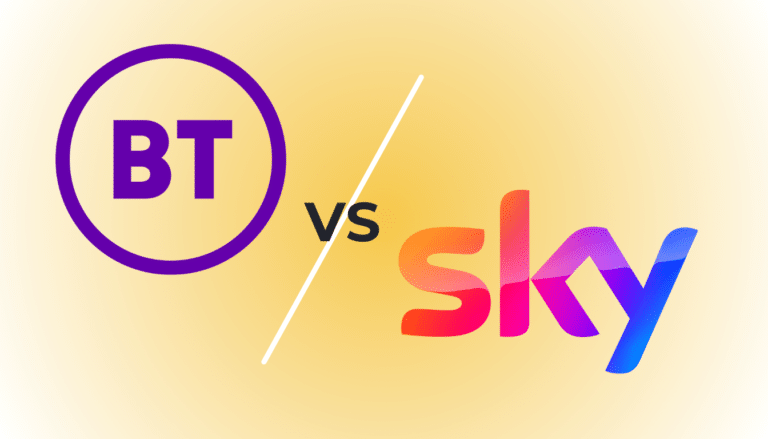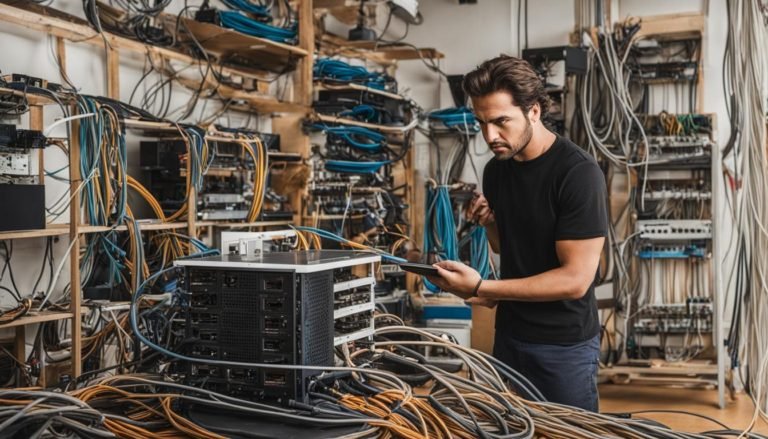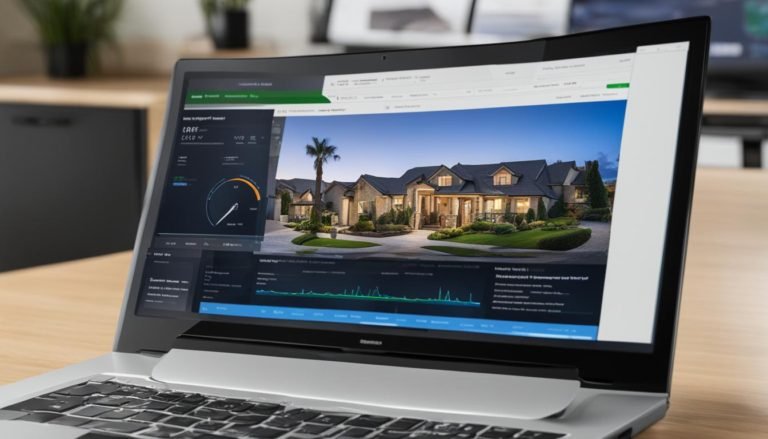Welcome to our comprehensive broadband speed guide. In this article, we will dive into the details of broadband speeds, helping you understand Mbps, download/upload speeds, and their significance for your internet experience. So, let’s get started!
Key Takeaways:
- Understanding broadband speeds is crucial for optimizing your internet experience.
- Broadband speeds are measured in Mbps and determine how quickly you can download and upload data.
- Download speed refers to retrieving data from the internet, while upload speed refers to sending data from your device.
- Fast upload speeds are vital for activities like video conferencing, streaming, and file uploads.
- You can measure your broadband speeds using online tools and perform regular speed tests.
The Difference Between Download and Upload Speeds
When it comes to broadband speeds, it’s important to understand the difference between download and upload speeds. Download speed refers to the rate at which you can retrieve data from the internet, such as downloading files, streaming videos, or browsing websites. It is typically the speed that most people are familiar with and often the one advertised by internet service providers. On the other hand, upload speed refers to the rate at which you can send data from your device to the internet, such as uploading files or participating in video calls.
While download speed is crucial for accessing content online, upload speed has become increasingly important in recent years. With the rise of video conferencing, online collaboration, and cloud-based services, having fast upload speeds is essential for clear and uninterrupted communication, smooth video streaming, and faster file transfers.
To give you a better understanding, here’s a simple analogy: think of download speed as the highway that allows you to bring information into your device, while upload speed is the road that allows you to send information out to the internet. Both are necessary for a balanced and efficient internet experience.
The Difference Between Download and Upload Speeds
| Download Speeds | Upload Speeds | |
|---|---|---|
| Definition | The rate at which data is received from the internet to your device | The rate at which data is sent from your device to the internet |
| Common Uses | Downloading files, streaming videos, browsing websites | Uploading files, participating in video calls, using cloud-based services |
| Importance | Crucial for accessing online content | Increasingly important for video conferencing, online collaboration, and file transfers |
The Importance of Upload Speed
When it comes to our online activities, fast upload speeds are more important than ever. Whether you’re participating in video conferencing, making video calls to loved ones, or uploading files to the cloud, having a high upload speed is crucial for a smooth and seamless experience.
Fast upload speeds ensure clear and uninterrupted communication during video conferencing sessions, making it easier to collaborate with colleagues or attend online meetings. With the rise of remote work and virtual communication, having a reliable upload speed can make a significant difference in productivity and overall user experience.
Not only that, but fast upload speeds also enhance the quality of video calls. With a higher upload speed, you can enjoy clearer and more stable video connections, allowing you to connect with friends and family with ease. Whether it’s catching up with loved ones or attending virtual social gatherings, a fast upload speed ensures that you don’t miss any important moments.
Furthermore, fast upload speeds enable faster file transfers, making it quicker and more efficient to upload large files to the cloud. Whether you’re backing up important documents, sharing multimedia content, or working with remote teams on collaborative projects, a higher upload speed ensures that your files are uploaded in a timely manner, saving you time and frustration.
| Activities | Recommended Upload Speed |
|---|---|
| Video Conferencing | 5 Mbps or higher |
| Video Calls | 3 Mbps or higher |
| Cloud File Uploads | 10 Mbps or higher |
As you can see, having fast upload speeds is essential for a range of online activities. Whether it’s for work, communication, or file management, a higher upload speed ensures that you can carry out these tasks smoothly and efficiently. So, when choosing an internet plan or evaluating your current broadband speeds, don’t overlook the importance of upload speed.
How to Measure Your Broadband Speeds
When it comes to broadband speeds, it’s essential to have a clear understanding of how fast your internet connection is. This can help you determine if you’re getting the performance you expect and if there are any issues that need to be addressed. Luckily, measuring your broadband speeds is a simple process that can be done using speed tests.
A speed test allows you to check both your download and upload speeds and provides an accurate measurement of your internet connection. There are various online tools and apps available that make it easy to perform a speed test. Simply run the test, and within seconds, you’ll receive your results, including your Mbps (megabits per second) for both downloading and uploading.
Regularly monitoring your broadband speeds is important, as it can help you identify any fluctuations or inconsistencies in your internet performance. By performing speed tests at different times of the day, you can also determine if there are specific peak usage periods when your speeds may be slower. This information can be useful when troubleshooting connectivity issues or when considering upgrading your internet package.

How to Interpret Speed Test Results
Once you’ve conducted a speed test, it’s important to understand how to interpret the results. The download speed represents how quickly you can retrieve data from the internet, while the upload speed indicates how fast you can send data from your device to the internet. Both speeds are measured in Mbps.
Typically, a higher download speed is desirable for activities like streaming videos, playing online games, and downloading large files. On the other hand, a higher upload speed is important for tasks such as video conferencing, participating in video calls, and uploading files to the cloud. If you engage in activities that require fast upload speeds, it’s essential to ensure that your internet package supports your needs.
| Activity | Recommended Download Speed | Recommended Upload Speed |
|---|---|---|
| Basic web browsing and email | At least 25 Mbps | At least 3 Mbps |
| Streaming HD videos | At least 50 Mbps | At least 5 Mbps |
| Online gaming | At least 50 Mbps | At least 10 Mbps |
| Video conferencing and calls | At least 25 Mbps | At least 10 Mbps |
| Large file uploads | At least 25 Mbps | At least 10 Mbps |
By measuring your broadband speeds and understanding the results, you can ensure that your internet connection is meeting your needs for various online activities. If you find that your speeds are consistently lower than expected, it may be worth reaching out to your internet service provider to discuss potential solutions or upgrade options.
Factors Affecting Broadband Speeds
When it comes to broadband speeds, several factors come into play that can affect the performance of your internet connection. Understanding these factors can help you identify potential issues and make improvements to enhance your internet speed. Let’s take a closer look at some of the key factors that can impact your broadband speeds.
The Internet Service Provider (ISP)
Your choice of Internet Service Provider can have a significant impact on your broadband speeds. Different ISPs offer varying levels of service quality and infrastructure. Some ISPs may allocate more bandwidth to their customers, resulting in faster speeds, while others may have limitations that can hinder your internet experience. Researching and selecting a reliable and high-speed ISP can make a noticeable difference in your broadband performance.
Connection Type
The type of connection you have can also affect your broadband speeds. Different connection types, such as DSL, cable, fiber optic, and satellite, have varying capabilities and limitations. For example, fiber optic connections generally offer faster speeds compared to DSL or cable connections. If you’re experiencing slow speeds, it may be worth considering upgrading to a faster and more advanced connection type.
Network Congestion
Network congestion occurs when there is a high volume of traffic on your internet service provider’s network. During peak usage times, such as evenings when many people are streaming videos or playing online games, network congestion can result in slower speeds. While you may not have control over network congestion, being aware of peak times can help you plan your online activities accordingly to minimize any negative impact on your internet speed.
Equipment Quality
The quality and condition of your equipment, such as your modem and router, can also impact your broadband speeds. Older or outdated equipment may not be capable of supporting higher speeds. Upgrading to newer and more advanced equipment can help ensure that you’re maximizing your internet connection’s potential speed. Additionally, optimizing the placement of your router within your home and minimizing interference from other devices can also contribute to improved broadband performance.
By considering and addressing these factors, you can take proactive steps to improve your broadband speeds and enjoy a faster and more reliable internet connection.
| Factors Affecting Broadband Speeds | Summary |
|---|---|
| Internet Service Provider (ISP) | The choice of ISP can greatly impact the quality and speed of broadband connections. Choosing a reliable and high-speed ISP is essential for optimal performance. |
| Connection Type | Different connection types have varying capabilities and limitations. Upgrading to a faster connection type, such as fiber optic, can significantly improve speeds. |
| Network Congestion | During peak usage times, network congestion can cause slower speeds. Being aware of peak times can help minimize the impact on internet speed. |
| Equipment Quality | Outdated or low-quality equipment can hinder broadband speeds. Upgrading to newer equipment and optimizing router placement can enhance performance. |
Broadband Speed Recommendations for Different Activities
When it comes to choosing the right broadband speed for your online activities, it’s important to consider the specific requirements of each activity. Here are some recommended broadband speeds for various common activities:
| Activity | Recommended Broadband Speed |
|---|---|
| Browsing and Email | At least 25 Mbps |
| Streaming Standard Definition Videos | At least 3 Mbps |
| Streaming High Definition Videos | At least 5 Mbps |
| Streaming 4K Ultra HD Videos | At least 25 Mbps |
| Online Gaming | At least 50 Mbps |
| Video Conferencing | At least 10 Mbps |
| Large File Uploads | At least 25 Mbps |
These recommendations serve as a general guide to help you determine the minimum speeds required for a smooth and enjoyable online experience. However, keep in mind that actual requirements may vary depending on factors such as the number of devices connected to your network and the quality of service provided by your internet service provider.
By choosing an internet plan that meets or exceeds the recommended speeds for your preferred activities, you can ensure faster and more reliable internet performance. It’s always a good idea to consult with your internet service provider to discuss your specific needs and requirements.
Is Your Current Speed Meeting Your Needs?
If you’re unsure whether your current broadband speed is sufficient for your needs, you can perform a speed test to measure both your download and upload speeds. This will give you a better understanding of your internet performance and whether you may need to consider upgrading your plan.
Remember that internet speed requirements can vary depending on the number of users and devices connected to your network, as well as the types of online activities you engage in. Regularly assessing your broadband speeds and making necessary adjustments can help ensure that you’re getting the best possible internet experience for your needs.
The Importance of Fiber Optic Broadband for Fast Speeds
Fiber optic broadband is a game-changer when it comes to internet speeds. With its lightning-fast performance, it revolutionizes the way we connect and interact online. Unlike traditional copper-based connections, fiber optics use light signals to transmit data, resulting in incredibly fast and reliable internet speeds. Whether you’re a heavy streamer, avid gamer, or remote worker, fiber optic broadband offers the speed you need for seamless online experiences.
When it comes to download and upload speeds, fiber optic broadband excels in both areas. With download speeds of up to 1,000 Mbps or higher, you can quickly retrieve files, stream high-definition videos, and enjoy smooth online gaming. But it’s not just about download speeds. Fiber optics also provide symmetrical upload speeds, ensuring fast and efficient data transfer for activities like video conferencing, cloud storage, and file sharing.
With fiber optic broadband, you can say goodbye to buffering and lagging. Whether you’re streaming your favorite TV shows, participating in virtual meetings, or uploading large files, fiber optics can handle it all. Its low latency and high bandwidth capabilities make it the ideal choice for bandwidth-intensive tasks, delivering unrivaled performance that keeps up with your digital lifestyle.
Upgrade to fiber optic broadband today and unlock the full potential of your internet connection. Experience blazing-fast speeds that empower you to do more online, whether it’s streaming, gaming, working, or connecting with others. With fiber optics, fast internet speeds are no longer a luxury but a necessity in today’s digitally-driven world.
How to Improve Your Broadband Speeds
When it comes to broadband speeds, we all want the fastest and most reliable connection possible. Slow internet can be frustrating, especially if you rely on it for work, entertainment, or staying connected with loved ones. Fortunately, there are several steps you can take to improve your broadband speeds and enjoy a smoother online experience.
Optimize Your Connection
One of the first things you can do to improve your broadband speeds is to use a wired Ethernet connection instead of relying solely on Wi-Fi. Wired connections tend to be more stable and faster, especially if you’re working with large files or streaming high-definition content. Additionally, ensure your router and modem are up to date. Old or outdated equipment can limit your speeds, so consider upgrading to newer models if necessary.
Minimize Interference
Interference from other devices can affect your Wi-Fi signal and slow down your internet speeds. To minimize interference, keep your router away from other electronics that emit signals, such as cordless phones and microwaves. Additionally, optimize your Wi-Fi settings by choosing the least congested Wi-Fi channel and securing your network with a strong password to prevent unauthorized access.
Check for Updates
Regularly checking for firmware updates for your router and modem is another important step in improving your broadband speeds. Manufacturers often release updates that can enhance performance and address known issues. By keeping your devices up to date, you can ensure you’re getting the most out of your internet connection.
| Steps to Improve Broadband Speeds | Description |
|---|---|
| Use a wired Ethernet connection | Wired connections are faster and more stable than Wi-Fi. |
| Upgrade your router and modem | Old or outdated equipment can limit your speeds. |
| Minimize interference | Keep your router away from devices that emit signals and optimize your Wi-Fi settings. |
| Check for firmware updates | Regularly update your router and modem to enhance performance. |
By following these tips, you can significantly improve your broadband speeds and enjoy a faster, more reliable internet connection. Remember, every home setup is unique, so it may take some trial and error to find the best configuration for your specific needs. Don’t hesitate to reach out to your internet service provider for further assistance. Happy browsing!
Conclusion
We hope this breakdown of broadband speeds has helped you make sense of the technical jargon and understand how it impacts your online experience. With the increasing importance of fast internet speeds, it’s essential to grasp the difference between download and upload speeds and how they affect activities like video streaming, gaming, and file sharing.
By following the recommended speed guidelines, you can ensure that your internet plan meets your specific needs. Additionally, considering fiber optic broadband can provide you with ultra-fast speeds and a reliable connection. It’s worth exploring if this option is available in your area.
Remember, there are several ways to improve your broadband speeds, such as using a wired Ethernet connection, optimizing your Wi-Fi settings, and keeping your equipment up to date. Taking these steps can help you maximize your internet performance and enjoy a seamless online experience.
So, whether you’re a casual web surfer or a heavy internet user, understanding the breakdown of broadband speeds empowers you to make informed decisions and get the most out of your internet connection. Stay connected, stay informed, and enjoy the fast-paced digital world at your fingertips.
FAQ
What is the difference between download and upload speeds?
Download speed refers to how quickly you can retrieve data from the internet, such as downloading files or streaming videos. Upload speed, on the other hand, refers to the rate at which you can send data from your device to the internet, like uploading files or participating in video calls.
Why is upload speed important?
Upload speed is becoming increasingly important as more people engage in activities like video conferencing and cloud-based services. It is crucial for clear and uninterrupted communication, smooth video streaming, and fast file transfers.
How can I measure my broadband speeds?
You can perform a speed test to determine your current broadband speeds. There are various online tools and apps available that allow you to quickly and easily test your download and upload speeds.
What factors affect broadband speeds?
Several factors can affect your broadband speeds, including your internet service provider, connection type, network congestion, and equipment quality. Upgrading to a higher-tier plan, using a wired Ethernet connection, optimizing your router placement, and ensuring your devices are free from malware can help improve your internet speed.
What are the recommended broadband speeds for different activities?
For basic browsing and downloading, speeds of at least 25 Mbps are considered good. However, activities like streaming high-quality videos or participating in online gaming may require higher speeds, ranging from 50 Mbps to 100 Mbps or more. It’s important to choose an internet plan that aligns with your specific needs and online activities.
Why is fiber optic broadband recommended for fast speeds?
Fiber optic broadband is known for its incredibly fast speeds. Unlike traditional copper-based connections, fiber optics use light to transmit data, resulting in faster and more reliable internet performance.
How can I improve my broadband speeds?
You can improve your broadband speeds by using a wired Ethernet connection, ensuring your router and modem are up to date, minimizing interference from other devices, optimizing your Wi-Fi settings, and periodically checking for any firmware updates.











